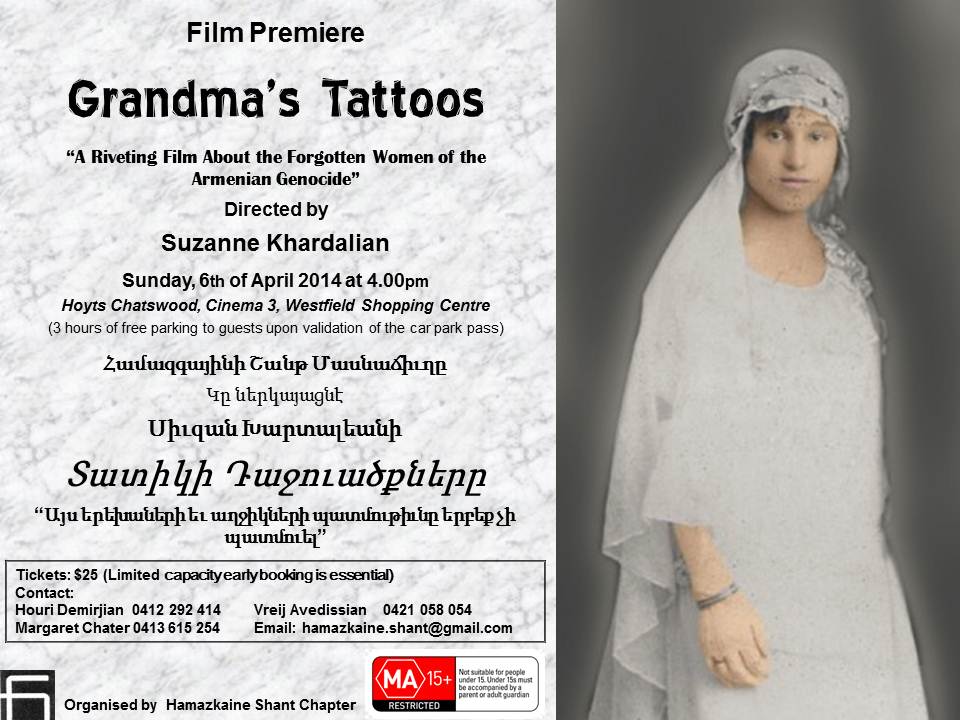Sydney screening of Grandma's Tattoos
By armenia.com.au | Tuesday, 25 March 2014

SYDNEY: Hamazkaine Shant Chapter has announced it will screen Grandma's Tattoos on April 6th at 4pm, at Hoyts Chatswood Westfield.
The following is their synopsis and statement:
“Grandma Khanoum was not like everyone else. As a child I remember her as a wicked woman. She despised physical contact. This was a grandma who never hugged, gave no kisses. And she wore those gloves, which hid her hands and the tattoos. They hid her secret.” This is how Suzanne Khardalian describes her grandmother.
Khardalian is the director and producer of riveting new film called “Grandma’s Tattoos” that lifts the veil of thousands of forgotten women—survivors of the Armenian Genocide—who were forced into prostitution and tattooed to distinguish them from the locals.
“As a child I thought these were devilish signs that came from a dark world. They stirred fear in me. What were these tattoos? Who had done them, and why? But the tattoos on grandma’s hands and face were a taboo. They never spoke about it,” explains Khardalian.
“Grandma’s Tattoos” is a journey into the secrets of the family. Eventually, the secret behind Grandma Khanoum’s blue marks are revealed.
“Grandma was abducted and kept in slavery for many years somewhere in Turkey. She was also forcibly marked—tattooed—as property, the same way you mark cattle. The discovery of the story has shaken me. I share the shame, the guilt, and anger that infected my grandma’s life. Grandma Khanoum’s fate was not an aberration. On the contrary, tens of thousands of Armenian children and teenagers were raped and abducted, kept in slavery,” she explains.
In 1919, just at the end of World War I, the Allied forces reclaimed 90,819 Armenian young girls and children who, during the war years, were forced to become prostitutes to survive, or had given birth to children after forced or arranged marriages or rape. Many of these women were tattooed as a sign that they belonged to the abductor. European and American missionaries organized help and saved thousands of refugees who were later scattered all over the world to places like Beirut, Marseille, and Fresno.
The story of “Grandma’s Tattoos” is a personal film about what happened to many Armenian women during the genocide. It is a ghost story—with the ghosts of the tattooed women haunting us—and a mystery film, where many taboos are broken. As no one wants to tell the real and whole story, and in order to bring the pieces of the puzzle together, the director makes us move between different times and space, from today’s Sweden to Khardalian’s childhood in Beirut.
In the film we meet Grandma Khantoum’s sister, 98-year-old Lucia, who lives in Hollywood. Lucia, too, has those odd tattoos. She is willing to tell us only a part of the story. We also meet with Aunt Marie, Grandma’s only still-living child in Beirut. But Aunt Marie doesn’t know the whole story either. Grandma has never told it to her. It was forbidden to talk about the “unspeakable.” Aunt Marie has the same unpleasant memories as the rest of the family.
It’s finally Khardalian’s mother who tells the story about Grandma Khanoum, and about the Kurdish man who was supposed to help her grandma escape the killings but instead decided to abduct her and keep her as his concubine. Grandma was only a child then. She had just turned 12. The words “Mummy, mummy help me” is the sentence that haunts Suzanne and her family.
Hamazkaine Shant Chapter is proud to bring this untold story to Australian audiences. The documentary ‘Grandma’s Tattoos’ will be screened on April 6, 2014 at 4pm, Hoyts Chatswood Westfield.
A documentary in English. Rated M15+
Tickets: $25. To purchase tickets contact:
Hamazkaine Shant Chapter: hamazkaine.shant@gmail.com
Hourie Demirjian 0412 292 414, Margaret Chater 0413 615 254, Vreij Avedissian 0421 058 054
For online sales: www.trybooking.com/EIEN

About the Director: Suzanne Khardalian is an independent filmmaker and writer. She studied journalism in Beirut and Paris and worked as a journalist in Paris until 1985, when she started to work on films.. She has directed more than 20 films, including “Back to Ararat” (1988), “Unsafe Ground” (1993), “The Lion from Gaza” (1996), “Her Armenian Prince” (1997), “From Opium to Chrysanthemums” (2000), “Where Lies My Victory” (2002), “I Hate Dogs” (2005), “Bullshit” (2006), and “Young Freud in Gaza” (2009).
comments
More headlines
ARF Australia Protests Armenian Government Policies During Meeting with Sinanyan
MARCH TO FOREIGN AFFAIRS MINISTRY FRIDAY 1ST SEPTEMBER
PRESS RELEASE: Australian City Launches Humanitarian Appeal for Artsakh
PRESS RELEASE: The Armenian Film Festival Australia returns to Sydney and Melbourne!
MEDIA RELEASE: Joint Javakhk Committee TUMO Box Set for Launch in 2024
Tasmanian State Parliament in Australia Recognises Armenian, Assyrian and Greek Genocides
AYF Australia Writes an Open Letter to the Prime Minister Ahead of Armenian Genocide Commemoration
